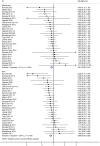Housing Improvements and Malaria Risk in Sub-Saharan Africa: A Multi-Country Analysis of Survey Data
- PMID: 28222094
- PMCID: PMC5319641
- DOI: 10.1371/journal.pmed.1002234
Housing Improvements and Malaria Risk in Sub-Saharan Africa: A Multi-Country Analysis of Survey Data
Abstract
Background: Improvements to housing may contribute to malaria control and elimination by reducing house entry by malaria vectors and thus exposure to biting. We tested the hypothesis that the odds of malaria infection are lower in modern, improved housing compared to traditional housing in sub-Saharan Africa (SSA).
Methods and findings: We analysed 15 Demographic and Health Surveys (DHS) and 14 Malaria Indicator Surveys (MIS) conducted in 21 countries in SSA between 2008 and 2015 that measured malaria infection by microscopy or rapid diagnostic test (RDT). DHS/MIS surveys record whether houses are built with finished materials (e.g., metal) or rudimentary materials (e.g., thatch). This information was used to develop a binary housing quality variable where houses built using finished wall, roof, and floor materials were classified as "modern", and all other houses were classified as "traditional". Conditional logistic regression was used to determine the association between housing quality and prevalence of malaria infection in children aged 0-5 y, adjusting for age, gender, insecticide-treated net (ITN) use, indoor residual spraying, household wealth, and geographic cluster. Individual survey odds ratios (ORs) were combined to determine a summary OR using a random effects meta-analysis. Of 284,532 total children surveyed, 139,318 were tested for malaria infection using microscopy (n = 131,652) or RDT (n = 138,540). Within individual surveys, malaria prevalence measured by microscopy ranged from 0.4% (Madagascar 2011) to 45.5% (Burkina Faso 2010) among children living in modern houses and from 0.4% (The Gambia 2013) to 70.6% (Burkina Faso 2010) in traditional houses, and malaria prevalence measured by RDT ranged from 0.3% (Senegal 2013-2014) to 61.2% (Burkina Faso 2010) in modern houses and from 1.5% (The Gambia 2013) to 79.8% (Burkina Faso 2010) in traditional houses. Across all surveys, modern housing was associated with a 9% to 14% reduction in the odds of malaria infection (microscopy: adjusted OR 0.91, 95% CI 0.85-0.97, p = 0.003; RDT: adjusted OR 0.86, 95% CI 0.80-0.92, p < 0.001). This association was consistent regardless of ITN usage. As a comparison, the odds of malaria infection were 15% to 16% lower among ITN users versus non-users (microscopy: adjusted OR 0.84, 95% CI 0.79-0.90, p < 0.001; RDT: adjusted OR 0.85, 95% CI 0.80-0.90, p < 0.001). The main limitation of this study is that residual confounding by household wealth of the observed association between housing quality and malaria prevalence is possible, since the wealth index may not have fully captured differences in socioeconomic position; however, the use of multiple national surveys offers the advantage of a large sample size and the elimination of many biases typically associated with pooling observational data.
Conclusions: Housing quality is an important risk factor for malaria infection across the spectrum of malaria endemicity in SSA, with a strength of association between housing quality and malaria similar to that observed between ITN use and malaria. Improved housing should be considered a promising intervention for malaria control and elimination and long-term prevention of reintroduction.
Conflict of interest statement
The authors have declared that no competing interests exist.
Figures


References
-
- Kirby M, Ameh D, Bottomley C, Green C, Jawara M, Milligan P, et al. Effect of two different house screening interventions on exposure to malaria vectors and on anaemia in children in The Gambia: a randomised controlled trial. Lancet. 2009;374:998–1009. 10.1016/S0140-6736(09)60871-0 - DOI - PMC - PubMed
-
- Knudsen J, von Seidlein L. Healthy homes in tropical zones: improving rural housing in Asia and Africa. Stuttgart: Edition Axel Menges; 2014.
Publication types
MeSH terms
Grants and funding
LinkOut - more resources
Full Text Sources
Other Literature Sources
Medical
Research Materials

